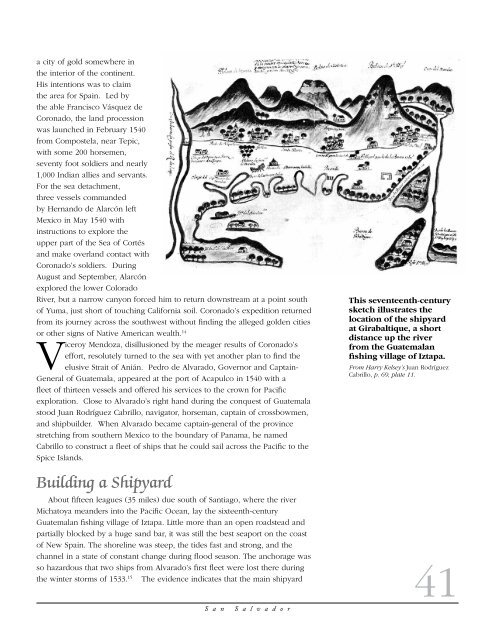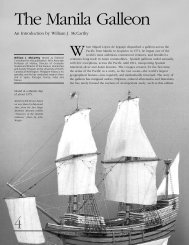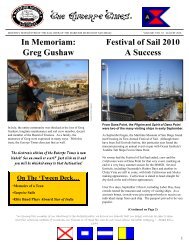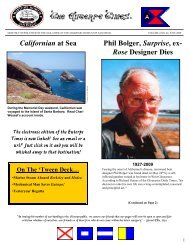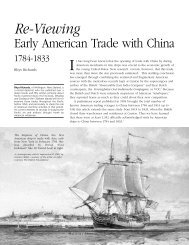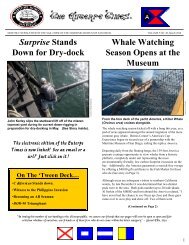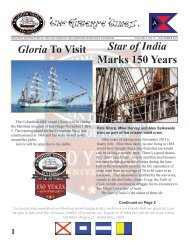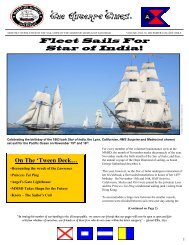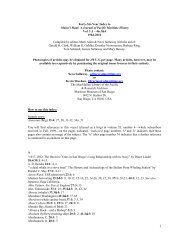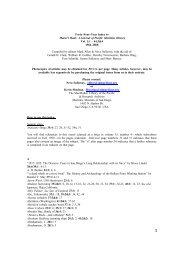Juan RodrÃguez Cabrillo And The Building Of The San Salvador
Juan RodrÃguez Cabrillo And The Building Of The San Salvador
Juan RodrÃguez Cabrillo And The Building Of The San Salvador
You also want an ePaper? Increase the reach of your titles
YUMPU automatically turns print PDFs into web optimized ePapers that Google loves.
a city of gold somewhere in<br />
the interior of the continent.<br />
His intentions was to claim<br />
the area for Spain. Led by<br />
the able Francisco Vásquez de<br />
Coronado, the land procession<br />
was launched in February 1540<br />
from Compostela, near Tepic,<br />
with some 200 horsemen,<br />
seventy foot soldiers and nearly<br />
1,000 Indian allies and servants.<br />
For the sea detachment,<br />
three vessels commanded<br />
by Hernando de Alarcón left<br />
Mexico in May 1540 with<br />
instructions to explore the<br />
upper part of the Sea of Cortés<br />
and make overland contact with<br />
Coronado’s soldiers. During<br />
August and September, Alarcón<br />
explored the lower Colorado<br />
River, but a narrow canyon forced him to return downstream at a point south<br />
of Yuma, just short of touching California soil. Coronado’s expedition returned<br />
from its journey across the southwest without finding the alleged golden cities<br />
or other signs of Native American wealth. 14<br />
Viceroy Mendoza, disillusioned by the meager results of Coronado’s<br />
effort, resolutely turned to the sea with yet another plan to find the<br />
elusive Strait of Anián. Pedro de Alvarado, Governor and Captain-<br />
General of Guatemala, appeared at the port of Acapulco in 1540 with a<br />
fleet of thirteen vessels and offered his services to the crown for Pacific<br />
exploration. Close to Alvarado’s right hand during the conquest of Guatemala<br />
stood <strong>Juan</strong> Rodríguez <strong>Cabrillo</strong>, navigator, horseman, captain of crossbowmen,<br />
and shipbuilder. When Alvarado became captain-general of the province<br />
stretching from southern Mexico to the boundary of Panama, he named<br />
<strong>Cabrillo</strong> to construct a fleet of ships that he could sail across the Pacific to the<br />
Spice Islands.<br />
<strong>Building</strong> a Shipyard<br />
This seventeenth-century<br />
sketch illustrates the<br />
location of the shipyard<br />
at Girabaltique, a short<br />
distance up the river<br />
from the Guatemalan<br />
fishing village of Iztapa.<br />
From Harry Kelsey’s <strong>Juan</strong> Rodríguez<br />
<strong>Cabrillo</strong>, p. 69, plate 11.<br />
About fifteen leagues (35 miles) due south of <strong>San</strong>tiago, where the river<br />
Michatoya meanders into the Pacific Ocean, lay the sixteenth-century<br />
Guatemalan fishing village of Iztapa. Little more than an open roadstead and<br />
partially blocked by a huge sand bar, it was still the best seaport on the coast<br />
of New Spain. <strong>The</strong> shoreline was steep, the tides fast and strong, and the<br />
channel in a state of constant change during flood season. <strong>The</strong> anchorage was<br />
so hazardous that two ships from Alvarado’s first fleet were lost there during<br />
41<br />
the winter storms of 1533. 15 <strong>The</strong> evidence indicates that the main shipyard<br />
S a n S a l v a d o r


